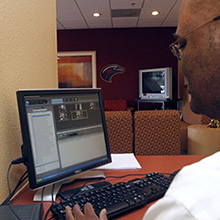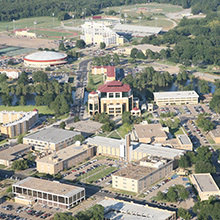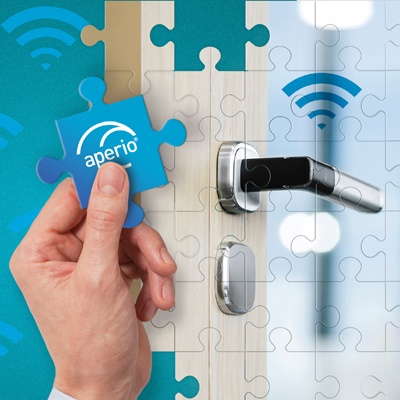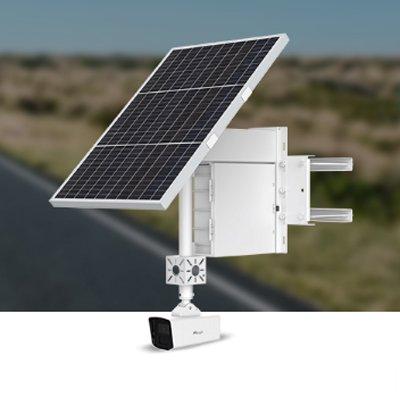 |
| Omnicast is managing close to 850 cameras throughout the most critical areas |
The University of Louisiana at Monroe has a history almost as rich and beautiful as the bayou that winds through its 238-acre campus. From its inception in 1931, the university was created to serve the educational and cultural needs of northeast Louisiana and to enlighten those from all over the world. In 2012, U.S. News & World Report deemed ULM one of the “best regional universities” in the south.
ULM offers traditional and online degrees from five colleges including the College of Arts and Sciences, the College of Business Administration, the College of Health Sciences, the College of Education and Human Development, and the College of Pharmacy. ULM also offers a variety of degree programs through the Graduate School.
Business challenge
With 8,560 students enrolled as of fall 2012, ULM's diverse student body contains students from all 50 states and 60 countries. More than 1,800 of those students live on campus. While ULM police are vigilant in ensuring campus security and safety, crime does occur, as it does in small community.
ULM Smart Classrooms, which are equipped with computers, projectors and other technologies, have been compromised in the past. Several departments such as the university police department (UPD) and the property control division made every effort to prevent the occurrences, however, without concrete evidence, ULM was unable to properly track the thefts and apprehend the suspects. It became clear to the ULM Computing Center team-those responsible for overseeing all technological installations on campus-that security technology would be required to help better protect university assets and safeguard students from potential threats.
Although some of the on-campus residence halls already were equipped with analogue-based digital video recorders (DVR), ULM Computing Center staff surveyed the technology and deemed it restrictive and obsolete. ULM initially opted for a network video recorder (NVR) to secure its smart classrooms. While resourceful and helpful in deterring the thefts, the technology's limitations were soon uncovered when requests for more and more cameras began flooding ULM's Computing Center. With limited storage, the NVR would be unable to accommodate growth beyond 64 cameras.
More so, their existing coax-based access control system began monopolising resources and causing reoccurring maintenance issues. Managing two separate security systems was also becoming a burden for the Computing Center team and the operators.
"We started conducting research on IP-based solutions for both video and access control,and we found that Genetec's solutions met our university's needs" |
Chance Eppinette, interim director for the Computing Center, and ULM colleagues Adam Taylor, video and wireless network technician, and David Calloway, IT tech support analyst, directed the initial phases of the project, but eventually enlisted the help of Genetec-certified integrators, United Automation, to deploy an enterprise level security platform that would secure more than 40 buildings across the ULM campus.
ULM security needs
First and foremost, ULM wanted an IP-based security system. According to Taylor, "There were a lot of DVR-based solutions on the market when we first started looking at our options. Vendors would tell us that we could hook the DVRs to the network, but that's not exactly an IP-based solution-that's a cobbled-together solution. We wanted to make sure that whatever we were doing was future-proof and since the marketplace was moving toward the IP route, that's where we wanted to go."
The network architecture would also allow ULM to upgrade their system to high-camera counts and not be limited to isolated deployments or a small number of cameras. Similarly, ULM required the flexibility from a highly scalable system. Due to limited funding and the likelihood that campus-wide deployment would span several years, the ability to add cameras increments-as funds became available-was a feasible option.
In fact, ULM required a system that would help maximise its financial investment. "Funding was kind of piece-meal from different departments," explained Eppinette. "For new facilities like our Intermodal Transit Facility, security system costs were built into the budget, however, the broader campus-wide deployment came from a capital outlay initiative that addressed security in general."
In that respect, ULM was also seeking an open-architecture system that would allow the migration of existing cameras and also take advantage of the newer technology as it emerged into the market. Cost-savings would also come from an intuitive system because less training would be required for day-to-day users. Finally, the ideal platform would have both video surveillance and access control combined in one unified solution to help ULM efficiently manage all aspects of campus security.
Equipped with the list of technology and financial requirements, the ULM Computing Center team exercised due diligence and made their final recommendation. "We started conducting research on IP-based solutions for both video and access control, and we also paid a visit to neighbouring Grambling State University. After some internal testing, we found that Genetec's solutions met our university's needs," confirmed Eppinette.
The right solution
ULM upgraded to Genetec's video surveillance system, Omnicast, and later the unified security platform, Security Center, which also includes the Synergis access control system. This process spanned over the course of several years.
 |
| The IP-based nature of Security Center has allowed ULM to leverage the campus network |
The flexibility of Genetec's solutions was evident from the onset, and afforded the ability to use varied budget approvals to advance the system. ULM started the implementation in smaller, manageable increments, adding one camera per classroom and migrating the old analogue system to the Omnicast video surveillance system. This was followed by a successful pilot project for the unified platform, which included Synergis access control in the residence halls. According to Taylor, "Residential Life was very happy with the system, so we started phasing out our old access control system, and we worked closely with United Automation to complete the implementation of our campus-wide system."
Today, Security Center's impressive scalability has proven to be the system's most pivotal feature. "We realised that the system was going to get extremely large after a while, but the Genetec solution helped us easily and gradually grow the system," said Taylor.
Omnicast is managing close to 850 cameras, and Synergis is managing over 300 secure, card-access doors throughout the most critical areas, such as classrooms, computer labs, the activity center, residence halls, and all main entrances and corridors. About 730 cameras are Axis Communications network cameras, including AXIS P3343 Fixed Dome, AXIS 225 Fixed Dome, and AXIS P1344 Network Cameras. Thanks to Security Center's open architecture, ULM was able to defer upgrade costs by preserving other networked cameras from the initial IP-based deployment. Furthermore, ULM's doors are equipped with a mix of HID Global VertX controllers, including GSC-V1000, GSC-V 100, GSC-V200 and GSC-V300 models, as well as HID Global readers such as ProxPoint Plus 6005, MiniProx 5365, ThinLine II 5395, and ProxPro 5355.
"We didn't want a hodge-podge of different cameras on campus, and the Axis cameras worked really well in the residence halls," said Taylor. "We could use the same model families for indoor and outdoor surveillance, and they were resistant to vandalism. The dome cameras also allowed for an easy installation for whatever ceiling structure existed, whether it was internal sheetrock, or exterior stucco."
In addition, the IP-based nature of Security Center has allowed ULM to leverage the campus network. To maximise their coverage, ULM's Computing Center team set up a star topology architecture that transmits data and video over a dedicated and private VLAN to their central data facility where 100 TB of storage is available. ULM is also using a Metro Ethernet connection to pull video and data from about 10 cameras in their remote pharmacy building, which is located three miles away from the core campus. With a massive number of cameras recording 24/7, ULM was able to use Omnicast to set video compression and streaming at 5 FPS in MPEG-4. This reduced network load and minimised storage costs while still enabling two-week retention periods.
Although the most critical video and doors are actively monitored by ULM's University Police Department, Security Center is mostly used during investigations. "Dispatch operators are usually monitoring as many entry doors as they can on their 52-inch screens, at one time. To help responding police officers, dispatchers can access cameras in a specific location when someone calls with an issue," confirmed Eppinette. At ULM, dispatch operators use building names and camera tree lists in Security Center to quickly retrieve archived video.
"We realised that the system was going to get extremely large after a while, but the Genetec solution helped us easily and gradually grow the system," |
On the access control side, UPD is also responsible for manually locking and unlocking doors on a case-by-case basis, such as after-hour entry, which is usually corroborated by video within the unified platform. ULM's Computing Center team has also given the Warhawk ID Services (WIDS) and Residential Life offices access to Security Center, defining user access privileges in the system. These privileges boost system security and simplify the user experience as they only handle system tasks that are relevant to their jobs.
The WIDS office uses Synergis to input and maintain all student and faculty ID cards and the Residential Life office will then manage building access privileges for residential students. When a card is missing, both departments can issue temporary cards and deactivate the old cards to prevent possible security breaches. The Residential Life office can also manually unlock doors for big move-in and move-out dates, so newcomers or graduates are not constantly swiping cards in residence buildings.
The benefits
Since deploying the unified security platform, ULM's UPD and other user departments such as Residential Life have experienced tremendous advantages. First and foremost, Security Center has helped ULM minimise theft and better respond to claims.
Following the installation of Omnicast in the residence halls, a case of theft from a house adjacent to the campus was reported. UPD was able to export time-stamped video of the suspect and burn the video onto a DVD for local authorities. "Most recently we had a theft in one of our buildings, and UPD did a tremendous job utilising the video system," said Tresea Buckhaults, director of Residential Life at ULM.
Beyond theft, ULM's Residential Life office is even pulling video from Omnicast to handle disputes of vandalism and better manage residence hall regulations. "The new system has really helped make our job a little bit easier," says Buckhaults. "We have policies, procedures and rules to uphold. If a student complains, we survey the video surveillance system and find out what happened. Even in cases where a student leaves trash in the hallways, we are able to identify that student."
A testament to Security Center's intuitive interface is ULM operators' ability to easily retrieve the archived video for investigations. Often dispatchers are given an incident and time frame, and are able to run a search to find the video they are seeking.
ULM is also able to use the campus-wide security platform as a marketing tool when prospective students and their parents tour the campus. "Parents are extremely impressed with our cameras and operating system," said ULM Acting Director of Police Lt. Steven Mahon. "When touring a college campus, safety is a top priority, and our systems help to put parents at ease."
"It makes the parents feel more comfortable," said Buckhaults. "They get a good feeling knowing that even though something may not be preventable, it can be addressed right away."
ULM has been able to leverage the openness of the security platform to develop four custom applications within Synergis, thanks to the help of United Automation and Genetec's custom development team. The first unique application was a toggle feature in Synergis that allowed professors to unlock and lock classroom doors before and after classes with a swipe of their card. Another custom integration in Synergis was with a car counter installed in the parking garage. Once the counter reaches the garage's maximum capacity of 250 cars, the barrier gates close. If the count goes below 250, the gates re-open, allowing more students to use the facility.
Security Center has also been integrated with the university's lighting system. Taylor explains, "At specified times during the night, if motion sensors installed in classrooms detect movement, it triggers an output in Security Center to turn on the lights. There is never a dark area, as soon as motion is detected, an operator can see what's happening."
Lastly, the residence halls have also been equipped with a new campus alert system, which was developed in response to the State Fire Marshals, who felt locks on shared bathroom doors could be a safety hazard. According to Brian Smith from United Automation, "We've helped ULM install an input device in dorm bathrooms that triggers an alarm in the system saying 'assistance needed in dorm 104.' So instead of having the student call into the dispatch centre, they would pull a switch on the wall, and an UPD operator would be able to dispatch a police officer to help the student."
In terms of security, ULM's Security Center deployment has made them a flagship organization in the State of Louisiana, drawing in other Security Directors from nearby hospitals, universities and K-12 school districts to witness the platform's capabilities first hand. Slowly but surely as more funding becomes available, ULM plans to swap out older technology for more Axis Communications IP cameras, invest in more storage, and upgrade to the latest version of Security Center to benefit from the most current enterprise-level features. Security Center has given ULM peace of mind, knowing that their security investment is protected and they can continue growing at their own pace.
In the meantime, with Security Center at the hands of operators, ULM continues to strive for a safe campus. According to Mahon, "Our staff works hard, and they take pride in the job they perform. The new security platform enhances our ability to make this campus safer and is a powerful crime-fighting tool."

















